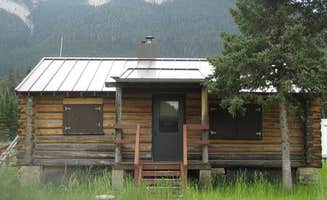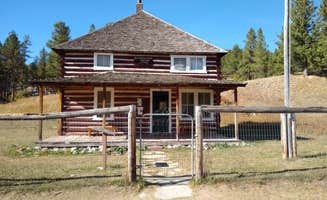Several cabin rentals near Lewistown, Montana provide rustic forest accommodations at elevations ranging from 5,500 to 7,000 feet. The surrounding Little Belt and Judith Mountains create distinct microclimates around each cabin location, with summer temperatures typically 10-15 degrees cooler than in Lewistown proper. Winter access often requires snowmobiles or cross-country skis for more remote cabin sites.
What to do
Hiking to ice caves: The trail near Crystal Lake Group Campsite offers a challenging but rewarding hike. "Beautiful views, the lake is amazing, and the hike to the ice caves, while difficult, is SO worth it," notes Megan B. The ice caves maintain freezing temperatures year-round, even during summer months.
Rock collecting adventures: Areas near Dry Wolf Cabin provide excellent opportunities for amateur geologists. K B. mentions, "Lots of activities nearby rock hounding/fossils, hikes, small waterfall, swimming in creek." The region contains fossils from the Cretaceous period and various mineral specimens.
Swimming opportunities: During warmer months, several creek access points provide natural swimming holes. According to visitor reviews, water temperatures remain cool even in late summer, rarely exceeding 65°F. Most swimming areas feature natural gravel or stone bottoms rather than mud.
What campers like
Midweek solitude: Many visitors appreciate the quiet weekday atmosphere at cabins during summer months. Jim from Crystal Lake Group Campsite reports, "We had the place to ourselves mid week it was so quiet. Lots of space between spots, easy to get into. Great get away."
Historical architecture: The two-story historic cabin at Judith Guard Station features period construction details. The station includes unexpected amenities like an old piano. Many cabins in the region date back to early Forest Service construction in the 1920s and 1930s.
Water accessibility: Most cabins provide some form of water access, though sources vary considerably. Crystal Lake has traditional drinking water facilities, while others require creek collection. At Judith Guard Station, "Water is available from a hand pump. and a vault toilet is next to the cabin," according to Dexter I.
What you should know
Seasonal lake fluctuations: The namesake Crystal Lake has experienced significant changes over time. Lindsay B. notes, "Allegedly, Crystal Lake drained into a limestone fissure in the earth. Bummer. But it's still an insanely beautiful area with hikes up to a year-round ice cave!"
Cooking facilities: Most cabins provide basic cooking setups, though specifics vary by location. K B. mentions Dry Wolf Cabin "has wood stove for cold winters. Propane stove makes cooking easy." Bring cooking implements and supplies as shopping options are minimal.
Privacy considerations: Site selection matters significantly at group areas. David P. observed at Crystal Lake Group Campsite, "Friday night and not a soul in sight. Like other reviews- very open. Staying on the outside provides better privacy, but with no one there - lots of privacy."
Tips for camping with families
Wildlife viewing opportunities: Morning and evening hours provide the best wildlife spotting times at most cabins. Children can frequently observe deer, various bird species, and occasionally elk from cabin porches. Some locations offer wildlife checklists for educational activities.
Temperature preparation: Mountain cabin elevations create significant temperature swings. Crystal Lake Cabin sits in a "mountain oasis in North Central Montana" according to Lindsay B., with evening temperatures often dropping below 45°F even in summer months. Pack appropriate layered clothing for children.
Activity planning: Consider cabin locations based on desired family activities. Some cabins provide direct trail access while others require short drives to recreation areas. Most cabins contain limited indoor entertainment options, so bring family games and activities.
Tips from RVers
Road conditions: Access roads to cabin areas vary significantly in quality. Many require high-clearance vehicles during spring thaw or after heavy rainfall. Some access roads feature steep grades exceeding 8-10% in sections.
Alternative accommodation options: When cabins are unavailable, some areas permit limited RV parking. However, amenities are typically minimal or nonexistent. Without standard hookups, RV campers should prepare for dry camping conditions.



